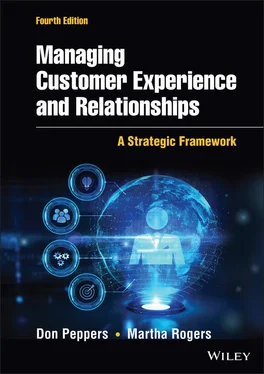Behavioral customer loyalty is easier to measure because it can be objectively observed, while assessing emotional loyalty requires more expensive and subjective polling and surveying techniques. Positive emotions and attitudes do tend to drive positive behaviors, but even if a firm observes loyal behavior , if the customer has no genuine emotional loyalty, then the relationship will be highly vulnerable to competition. If a competitor enters the market at a comparable price, for instance, the customer once loyal to your discount product can easily disappear. 13
The truth is, if an enterprise wants a clear and unambiguous guide to action, it needs to pay attention to both definitions of customer loyalty. Emotional loyalty without behavioral loyalty has no financial benefit for a firm, but behavioral loyalty without emotional loyalty is unsustainable. Defining loyalty purely as an emotional response is not very useful, because that attitude can exist completely apart from any continuing relationship on the part of a customer, and this simply flies in the face of the common English definition of the word loyalty . Customer A and Customer B might have an equally loyal attitude toward the image of a high-end perfume brand, but what if Customer A has terrible allergies to perfume, and could never consume the product, while Customer B has consumed it regularly in the past? Moreover, emotional loyalty and brand preference seem to be redundant, so why introduce a separate term at all? However, defining loyalty in purely behavioral terms is equally unsatisfactory. Case in point: Monopolies have behaviorally loyal customers.
Emotional loyalty without behavioral loyalty has no financial benefit for a firm, but behavioral loyalty without emotional loyalty is unsustainable.
A better insight into what customer loyalty really means can be gained by examining the policies companies introduce to improve it. A credit card company or mobile phone carrier, for instance, often concerns itself with reducing its customer churn rates. Churn is a term meaning defection or turnover. These companies often can count the customers who voluntarily elect to leave their franchises every month, and it is a legitimate and time-honored business practice to try to reduce this churn rate. A company usually tackles the churn problem with both reactive and proactive tactics. Reactive tactics can include predictive modeling to identifythose customers who are most likely to try to leave the franchise in the near future and then trying to intercede in advance; or actively trying to persuade churning customers not to leave at the point they announce they want to defect; or perhaps attempting to win defectors back immediately with offers of special pricing or improved services. Proactive tactics, however, can include identifying as many of the service and pricing problems that cause customers to want to leave in the first place, and trying to fix them; or perhaps designing new, customized products and services that do a better job of locking customers in for convenience reasons; or improving service friendliness and competence to increase customer affection for the brand.
A company trying to reduce its customer churn—and thereby increase its customer loyalty—shouldn't think of customer churn as a disease but as the symptom of a disease, somewhat like a fever. If a fever is severe enough, the doctor will want to treat it immediately and directly, but they also know that the only long-term solution to reducing a fever is to cure the underlying disease causing it. If we pursue this analogy, we could visualize a lack of behavioral loyalty in our customer base as a fever that is affecting our company while the actual disease causing this fever is a lack of emotional loyalty. 14
When dealing with the issue of customer loyalty, a firm should try to forge as direct a connection as possible to loyalty's actual financial results. That is, we ought to be able to connect whatever strategies and tactics we employ to increase our customers' loyalty with their actual economic outcomes. The customer-strategy enterprise will want to quantify the benefit of a customer's increasing loyalty, and the most direct and unambiguous metric to deploy for this task is the customer's lifetime value, as described in Chapter 6.
CUSTOMER RETENTION AND ENTERPRISE PROFITABILITY
Enterprises strive to increase profitability without losing high-margin customers by increasing their customer retention rates or the percentage of customers who have met a specified number of repurchases over a finite period of time. A retained customer, however, is not necessarily an emotionally loyal customer. The customer may give business to a competing enterprise for many different reasons. As far back as the 1990s, Royal Bank of Canada (RBC) developed superior computing and database power, along with sophisticated statistical programs, to analyze customer information and test specific actions it should take with specific customers. Only then could the bank's frontline personnel deliver more effective personal contact and attention to individual customers.
A retained customer is not necessarily an emotionally loyal customer.
To learn the most about its customers, RBC has undertaken an intense, ongoing statistical analysis of them. It is always developing and refining the prototype for an algorithm to model the long-term lifetime values of its individual customers. Part of this effort includes a client-potential model that measures how growable certain kinds of customers are to the bank. The bank also analyzes a customer's vulnerability to attrition and tries to flag the most vulnerable before they defect, in order to take preventive action in a focused, effective way.
To expand share of customer, RBC also tries to predict statistically which additional services a customer might want to buy, and when. RBC not only makes different offers to different customers, but it also equips its sales and service people with detailed customer profiles. Thus, rather than providing a one-size-fits-all service, the bank's customer-contact people spend their time and energy making on-the-spot decisions based on each customer's individual situation and value. 15 Note that this type of business practice not only benefits from individual customer interactions, but it also requires individual interactions to achieve the greatest success. As an RBC executive told the authors of this book, the bank discovered it “could lift contributionsand penetration rates by up to 10% by virtue of the contact alone.”
In 1990, Fred Reichheld and W. Earl Sasser analyzed the profit per customer in different service areas, categorized by the number of years that a customer had been with a particular enterprise. 16 In this groundbreaking study, they discovered that the longer a customer remains with an enterprise, the more profitable they become. (Several studies since then have indicated that relationship longevity is not a perfect predictor of profitability, but more often than not, the thesis has been supported by research.) Average profit from a first-year customer for the credit card industry was $30; for the industrial laundry industry, $144; for the industrial distribution industry, $45; and for the automobile servicing industry, $25. But those profits grow over time, the longer a customer does business with a company.
Four factors contribute to the underlying customer profit growth:
1 Profit derived from increased purchases. Customers grow larger over time and need to purchase in greater quantities.
2 Profit from reduced operating costs. As customers become more experienced, they make fewer demands on the supplier and fewer mistakes when involved in the operational processes, thus contributing to greater productivity for the seller and for themselves.
Читать дальше












